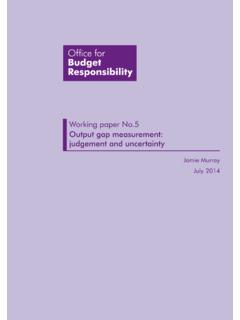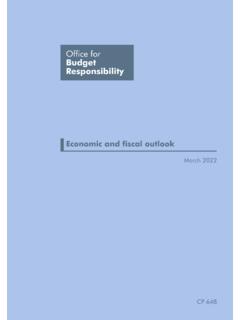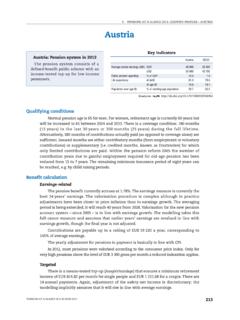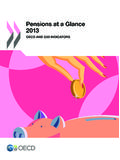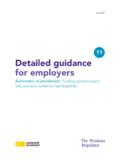Transcription of i Budget Responsibility
1 Welfare trends report Office for Budget Responsibility Welfare trends report January 2018. January 2018. CCS0917061496. ISBN 978-1-5286-0039-2 Cm 9562. Office for Budget Responsibility : Welfare trends report Presented to Parliament by the Exchequer Secretary to the Treasury by Command of Her Majesty January 2018. Cm 9562. Crown copyright 2018. This publication is licensed under the terms of the Open Government Licence except where otherwise stated. To view this licence, visit or write to the Information Policy Team, The National Archives, Kew, London TW9 4DU, or email: Where we have identified any third party copyright information you will need to obtain permission from the copyright holders concerned. This publication is available at Any enquiries regarding this publication should be sent to us at ISBN 978-1-5286-0039-2.
2 CCS0917061496 01/18. Printed on paper containing 75% recycled fibre content minimum Printed in the UK by the APS Group on behalf of the Controller of Her Majesty's Stationery Office Contents Foreword .. 1. Executive summary .. 3. Chapter 1 Introduction .. 15. Chapter 2 What will universal credit replace? .. 27. Chapter 3 The design of universal 59. Chapter 4 How we forecast spending on universal credit .. 79. Chapter 5 The full spending effects of universal credit .. 115. Chapter 6 The actual effects of universal credit on spending .. 127. Chapter 7 Risks and uncertainties .. 137. Index of charts and tables .. 155. Foreword The Office for Budget Responsibility (OBR) was created in 2010 to provide independent and authoritative analysis of the UK's public finances. In December 2013, the Government asked the OBR to take on additional responsibilities in relation to its newly announced cap on a subset of welfare spending, which was then quantified in the March 2014 Budget .
3 This request was in two parts: to assess the Government's performance against the welfare cap and to prepare and publish information on the trends in and drivers of welfare spending within the cap , so as to facilitate open and constructive debate. Parliament formally included these requirements in the Charter for Budget Responsibility when it was updated in October 2015. In our first Welfare trends report (WTR), we presented a broad survey of historical trends and our latest judgements on the prospects for benefits and tax credits spending. Our second considered the UK's public spending on social protection a broader definition of welfare spending in international context. Our third looked at how policy changes affected welfare spending over the 2010 to 2015 and the then planned 2015 to 2020 Parliaments relative to a counterfactual in which spending increased in line with demographics and pre-existing uprating policy.
4 This year's report seeks to increase transparency around one particularly complex and uncertain part of our forecast: the introduction of universal credit' (UC), which in coming years will absorb most existing benefits and tax credits paid to people of working age. Once fully rolled out, UC is expected to make up around a quarter of all welfare spending and around two-thirds of working- age welfare spending. Around seven million individuals and families are expected to be in receipt of it by the mid-2020s. Reflecting the remit Parliament has given us, our focus here is on the potential cost of UC, not on its distributional impact, the efficiency of its delivery, its value for money or its contribution to government policy objectives, important though these are. The analysis in this report represents the collective view of the OBR's Budget Responsibility Committee.
5 We take full Responsibility for the judgements that underpin it and for the conclusions we have reached. We have, of course, been supported in this by the full-time staff of the OBR, to whom we are enormously grateful. And we have also drawn on the help and expertise of officials across government, in particular from the Department for Work and Pensions and HM Revenue and Customs. We have been provided with all the information and analysis that we requested. We are also grateful to external stakeholders who gave their time and shared their expertise. In particular, we would like to thank Professor Sir John Hills at the London School of Economics, David Finch at the Resolution Foundation and Andrew Hood at the Institute for Fiscal Studies. 1 Welfare trends report Foreword As with all our reports, the WTR remains a work-in-progress.
6 We have refined and modified our other reports in response to feedback from users and we would be very keen to hear suggestions on the scope and format of this report. We provided the Chancellor with a final copy of the report 24 hours in advance of publication. Robert Chote Sir Charles Bean Graham Parker CBE. The Budget Responsibility Committee Welfare trends report 2. Executive summary 1 The introduction of universal credit (UC) is one of the most significant reforms to the welfare system since the Beveridge Report. It will replace six existing means-tested benefits and tax credits for people of working age, paying more than 60 billion a year to around 7 million households by the time it is fully rolled out. 2 The move to UC has been and remains an enormous design and delivery challenge for the Government, notably the Department for Work and Pensions (DWP).
7 The rollout has already been delayed repeatedly. And UC is now designed to save money, relative to the legacy system it replaces, rather than to cost more, as in the original vision. A welfare reform of this scale and nature is also a huge forecasting challenge and a source of significant risk to the Treasury in terms of public spending control. 3 At first glance, the implications of UC for the public finances look modest. In the absence of the reform, we estimate that the legacy system would cost billion in 2022-23. On the current design, UC would reduce that by billion. But this small saving is the net effect of billion of gross savings and billion of gross costs. (The underlying net saving is a slightly larger billion, if you exclude billion of temporary payments to some people moved to UC.) If any errors predicting these gross savings and costs add to rather than offset each other we could see large errors in the forecast for overall spending.
8 Chart 1: Universal credit and the legacy system in 2022-23. 70. 60 50. 40. billion 30. 20. 10. 0. Cost if the legacy Gross savings from Gross costs from Cost after net savings system was retained universal credit universal credit from universal credit (including transitional protection). Source: DWP, OBR. 3 Welfare trends report Executive summary 4 Many of the features of UC that lead to these costs and savings are highly uncertain in their impact. This arises from the uncertain outlook for the economy and labour market, the complexity of modelling the new system with limited information and sometimes poorly integrated models, and the difficulty of predicting how people's behaviour will respond to altered financial incentives and the wider imposition of conditions on claimants. 5 The introduction of UC will see conditions extended to claimants in work for the first time (as well as to more out-of-work claimants).
9 DWP's work coaches' must decide whether claimants are working sufficient hours or earning enough to receive UC (or, if they are self- employed, whether they are gainfully' so). The coaches will have discretion over the conditions and will be able to impose sanctions if they are not met. Much will depend on how they operate in practice and if their decisions are challenged. 6 Assessing the cost of UC once it is fully rolled out is difficult enough, but forecasting exactly how spending will evolve over the remaining five-year transition brings additional challenges not least because the pace and composition of the roll-out is uncertain and only partly under government control. Migration of claimants to UC is already making it hard to interpret spending data in real time, as DWP cannot tell us what the UC recipients would have been receiving in the legacy system.
10 This will become more of a problem as the overlap widens. This information gap will also make it harder to evaluate the impact on spending after the event, for example via changes to entitlement and take-up. 7 DWP has several trials underway to understand how UC will affect claimants' labour market outcomes, arguing that it will deliver additional savings and economic benefits by getting more people into work and onto higher earnings. Studies to date find modest, but positive effects. But we have not yet incorporated these into our forecasts, as it is not yet clear that the impact found for the simple cases migrated so far will be replicated for the more complex ones to come or if the resources devoted to the early cases will be sustained. 8 The quantitative analysis in this report is based on the current policy design for UC, albeit with some elements still to be finalised.

